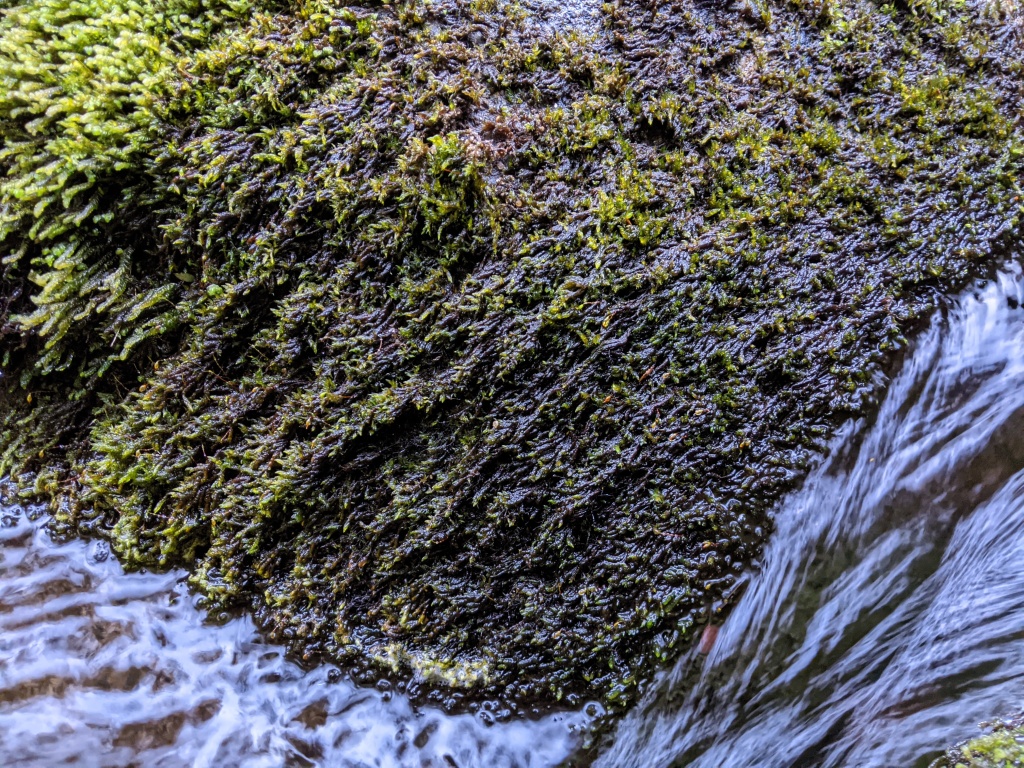Sematophyllum
Dioicous or rarely autoicous. Asexual reproduction sometimes by gemmae on leaf margins or rarely by axillary gemmae (not in Victoria). Mats or tufts on soil, rocks, logs or tree trunks and branches, occasionally submerged. Stems creeping, irregularly to pinnately branched, with fascicles of rhizoids on the ventral surface; pseudoparaphyllia foliose or filiform; central strand absent. Branch and stem leaves similar, elliptic, oblong, ovate or lanceolate, straight or falcate, arranged around stem and facing all directions, erect to wide-spreading and often secund when moist, similar when dry; apex obtuse, acute or acuminate, without a hairpoint; costa absent or short and double (not in Victoria); margins entire or denticulate, plane, recurved or incurved at base, without a border; laminal cells rhomboidal, fusiform, oblong to linear, most much longer than wide, smooth, unistratose; alar cells clearly differentiated, variable, usually consisting of 3–5 oblong and enlarged or inflated cells in alar angles transitioning abruptly into regular laminal cells or surrounded by few to numerous irregular to quadrate cells, rarely with several enlarged cells surrounded by fewer irregular cells (not in Victoria). Seta smooth or papillose. Capsules erect to pendent, straight or slightly curved, cylindric to ovoid, without an annulus. Calyptra cucullate, smooth, glabrous. Operculum rostrate. Persitome double; endostome segments incurved when dry, same length as exostome teeth; cilia present or occasionally rudimentary or absent.
Around 170 species from temperate to tropical regions throughout the world and some subantarctic islands have been recognised in Sematophyllum (Ochyra 2010), however, many of these are likely misplaced in Sematophyllum (see below); five species in Victoria.
Sematophyllum in its current circumscription likely encompasses several lineages closer related to other genera and is in need of worldwide revision (Carvalho-Silva et al. 2017; Han & Jia 2020). Partial revision based on phylogenies of DNA sequences from all genomic compartments that incorporated nine Sematophyllum species was initiated by Carvalho-Silva et al. (2017). They erected new genera for lineages containing Sematophyllum species, including Brittonodoxa that includes Victorian S. subpinnatum (Brid.) E.Britton and transferred other Sematophyllum species to closely related existing genera. Several of the Sematophyllum species that were well-separated in the phylogeny from S. demissum (A.Wilson) Mitt., the type of Sematophyllum, were retained in Sematophyllum, including the Victorian S. homomallum (Hampe) Broth. A broad circumscription of Sematophyllum provided by Ramsay et al. (2002) is tentatively followed here until a more complete revision of Sematophyllum is conducted based on more comprehensive sample of Sematophyllum species.
 Spinning
SpinningCarvalho-Silva, M.; Stech, M.; Soares-Silva, L.H.; Buck, W.R.; Wickett, N.J.; Liu, Y.; Câmara, P.E.A.S. (2017). A molecular phylogeny of the Sematophyllaceae s.l. (Hypnales) based on plastid, mitochondrial and nuclear markers, and its taxonomic implications. Taxon 66: 811–831.
Han, W.; Jia, Y. (2020). Phylogeny and classification of the Sematophyllaceae s.l. (Hypnales, Bryophyta). *Journal of Systematics and Evolution * 59: 524–540.
Ochyra, R. (2010). Antipodal mosses: XVI. The first record of the genus Sematophyllum (Sematophyllaceae) in the Subantarctic, with a description of S. lebouvieri sp. nov. Cryptogamie, Bryologie 31: 223–232.
Ramsay, H.P.; Schofield, W.B.; Tan, B.C. (2002). The family Sematophyllaceae (Bryopsida) in Australia. Part 1: Introduction, family data, key to genera and the genera Wijkia, Acanthorrhynchium, Trimegistia and Sematophyllum. *Journal of the Hattori Botanical Laboratory * 92: 1–50.




